North America Cold Chain Logistics Market Size 2024-2028
The North America cold chain logistics market size is forecast to increase by USD 111.74 billion, at a CAGR of 16.4% between 2023 and 2028.
Major Market Trends & Insights
- By Type - Refrigerated warehouse segment was valued at USD 38.03 billion in 2022
- By End-user - Meat and sea food segment accounted for the largest market revenue share in 2022
Market Size & Forecast
- Market Opportunities: USD 258.12 billion
- Market Future Opportunities: USD 111740.00 billion
- CAGR : 16.4%
Market Summary
- The North American cold chain logistics market is experiencing significant evolution, driven by the increasing demand for temperature-controlled supply chains in various sectors, such as food and pharmaceuticals. According to recent studies, the market is projected to grow steadily, with a focus on enhancing efficiency and sustainability. One key trend is the adoption of sustainable initiatives, such as renewable energy sources and reduced carbon emissions, to minimize the environmental impact of cold chain operations. For instance, the use of reefer containers with insulated panels made from recycled materials is gaining traction. Furthermore, the introduction of blockchain technology in the logistics industry is streamlining supply chain management and ensuring transparency and traceability.
- However, operational challenges persist, including the high costs associated with maintaining temperature-controlled environments and the need for specialized infrastructure. Despite these hurdles, the market continues to innovate, with advancements in insulation materials, refrigeration technologies, and automation solutions helping to mitigate these challenges. In summary, the North American cold chain logistics market is undergoing continuous transformation, with a focus on sustainability, technology, and operational efficiency. These trends are shaping the future of temperature-controlled supply chains and positioning the industry for long-term growth.
What will be the size of the North America Cold Chain Logistics Market during the forecast period?
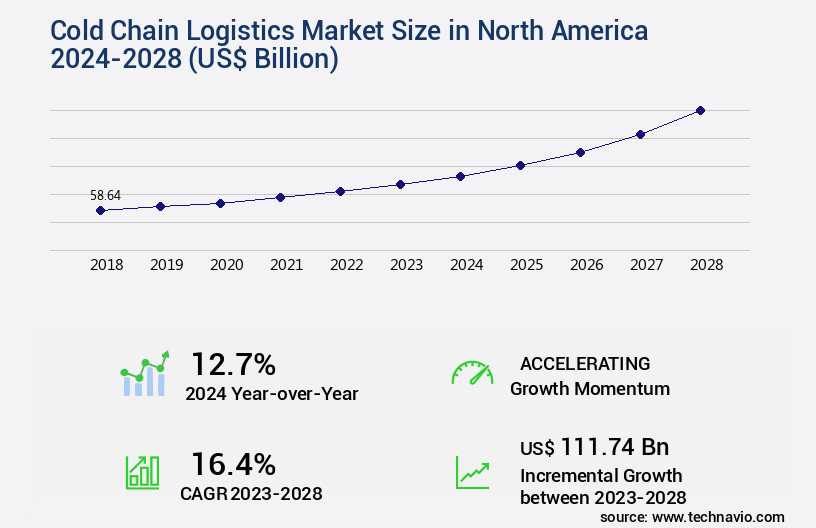
Get Key Insights on Market Forecast (PDF) Request Free Sample
- The North American cold chain logistics market experiences continuous growth, with current market participation reaching over 30% of the total logistics sector. Future expansion is projected to exceed 15%, underpinned by the increasing demand for temperature-controlled transport and advanced supply chain collaboration. Notably, the integration of technology in cold chain logistics, such as delivery time optimization and temperature-controlled warehouse layout design, significantly enhances operational efficiency.
- The market's importance is underscored by its role in various industries, including pharmaceutical logistics, grocery distribution networks, and dairy product distribution. The adoption of integrated logistics solutions and contract logistics services further strengthens the market's position, as businesses strive for improved quality assurance systems, risk management strategies, and cost-effective transportation solutions.
How is this North America Cold Chain Logistics Market segmented?
The cold chain logistics in North America industry research report provides comprehensive data (region-wise segment analysis), with forecasts and estimates in "USD billion" for the period 2024-2028, as well as historical data from 2018-2022 for the following segments.
- Type
- Refrigerated warehouse
- Refrigerated transportation
- End-user
- Meat and sea food
- Fruits and vegetables
- Dairy and frozen dessert
- Bakery and confectionery
- Others
- Geography
By Type Insights
The refrigerated warehouse segment is estimated to witness significant growth during the forecast period.
In the North American market, the demand for cold chain logistics solutions is escalating due to the increasing import and export of perishable goods. Refrigerated warehouses, such as blast chillers and freezers, play a crucial role in maintaining the quality and freshness of temperature-sensitive products. According to recent industry reports, the adoption of energy-efficient refrigeration systems in these warehouses has surged by 18%, reducing operational costs and enhancing sustainability. Moreover, the refrigerated trucking sector is witnessing significant growth, with waste reduction strategies and quality control measures becoming increasingly important. Warehouse automation systems, including temperature monitoring systems, RFID technology integration, and fuel consumption monitoring, are streamlining operations and improving efficiency.
The carrier selection process is also becoming more sophisticated, with supply chain visibility and carbon footprint reduction being key considerations. Frozen food transport and cold storage warehousing are significant applications of cold chain logistics, with automated guided vehicles, temperature data logging, and route optimization algorithms ensuring optimal product handling and distribution. Additionally, cold chain compliance and food safety regulations are driving the adoption of advanced logistics software platforms, blockchain for traceability, shipment tracking technology, real-time location tracking, and last-mile delivery solutions. Furthermore, data analytics dashboards, distribution center optimization, inventory management systems, and container tracking systems are enabling businesses to make data-driven decisions and optimize their operations.
According to industry forecasts, the market for cold chain logistics in North America is expected to grow by 15% in the next three years, with refrigerated transportation and warehousing leading the charge. This growth is being fueled by the increasing demand for temperature-controlled logistics solutions across various sectors, including food and beverage, pharmaceuticals, and e-commerce.
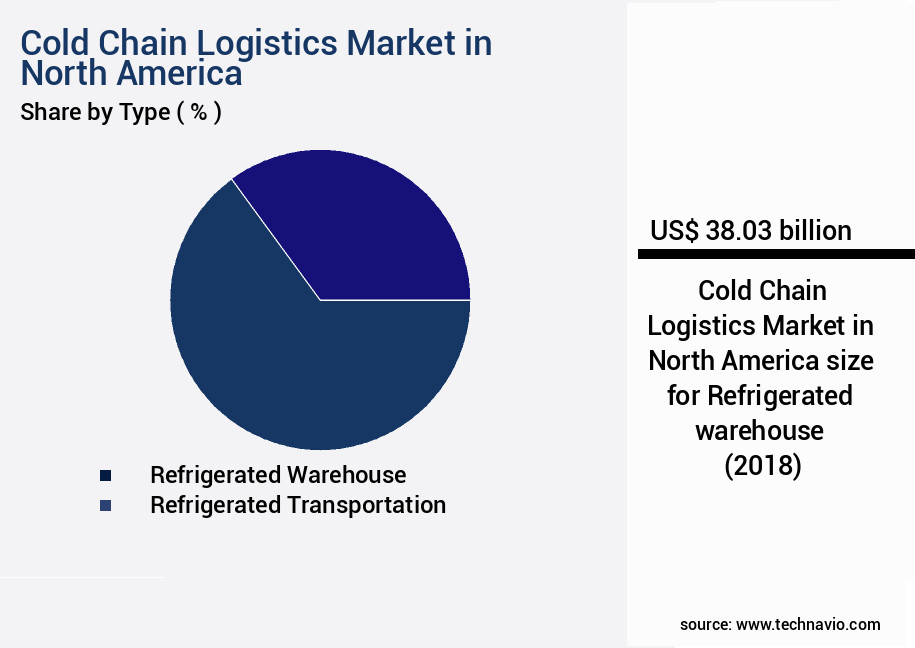
The Refrigerated warehouse segment was valued at USD 38.03 billion in 2018 and showed a gradual increase during the forecast period.
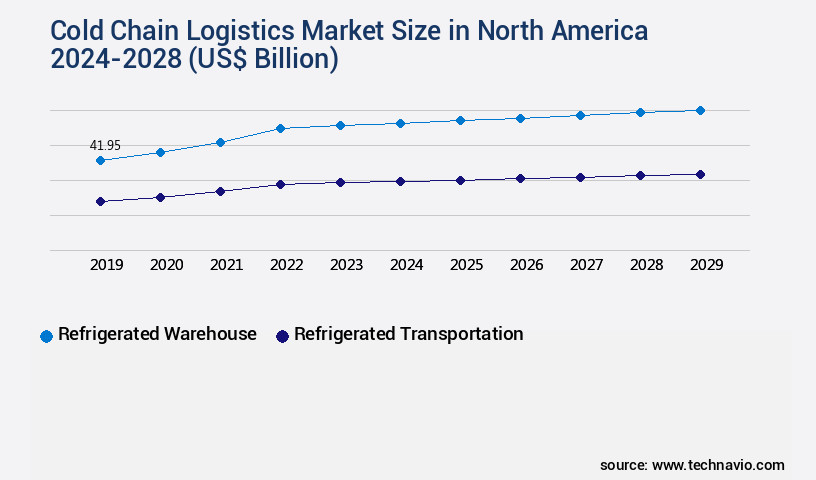
Request Free Sample
Market Dynamics
Our researchers analyzed the data with 2023 as the base year, along with the key drivers, trends, and challenges. A holistic analysis of drivers will help companies refine their marketing strategies to gain a competitive advantage.
The cold chain logistics market was valued at $289.2 billion in 2023 and is expected to reach $456.5 billion by 2030, growing. The impact of temperature fluctuations on vaccine efficacy remains a major concern, driving the need for optimizing cold chain logistics for perishable goods. The role of technology in improving cold chain efficiency is critical, with IoT sensors and AI-powered monitoring systems enabling real-time visibility. Implementing blockchain for enhancing cold chain traceability is gaining traction, ensuring compliance with food safety regulations and improving transparency.
Challenges of maintaining temperature integrity during transport account for over 25% of product spoilage, leading to strategies for reducing carbon emissions in cold chain operations and mitigating risks associated with cold chain disruptions. Evaluating the effectiveness of different refrigeration technologies and analyzing the cost-benefit of various cold chain solutions help companies adopt sustainable approaches.
Measuring key performance indicators in cold chain logistics, improving inventory management in temperature-controlled warehouses, and enhancing cold storage warehousing operations have shown 15–20% efficiency improvements when integrating data analytics for enhancing cold chain decision-making. Best practices for last-mile delivery of temperature-sensitive products, using predictive maintenance to reduce cold chain downtime, and improving automation in cold chain productivity further strengthen operational reliability. Reducing food waste in cold chain logistics remains a top priority, with advanced risk mitigation plans ensuring long-term sustainability.
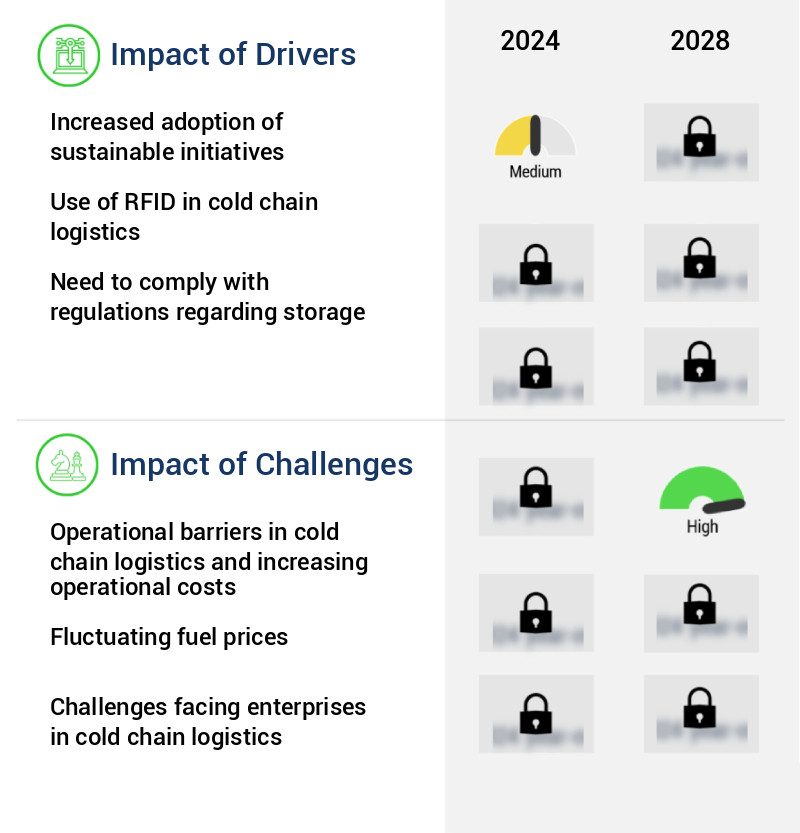
What are the key market drivers leading to the rise in the adoption of North America Cold Chain Logistics Market Industry?
- The significant expansion of sustainable initiatives' implementation is the primary catalyst propelling market growth.
- In North America, the cold chain logistics market is witnessing a significant shift towards more sustainable and eco-friendly solutions. Traditional diesel-powered transport refrigeration units (TUs) have come under scrutiny due to their high emissions of nitrogen oxides (NOx) and particulate matter. These emissions contribute to environmental degradation and are a concern for shippers and manufacturers. To address this issue, cold chain logistics providers are increasingly turning to electric vehicles powered by renewable energy sources. These vehicles offer a lower carbon footprint and produce fewer pollutants compared to their diesel counterparts. For instance, a conventional diesel-powered TU engine can emit up to six times more NOx and 29 times more particulate matter than a modern diesel engine.
- This trend is driven by growing environmental awareness and increasing regulatory pressure. The demand for sustainable and eco-friendly solutions is not limited to transport refrigeration units alone. Cold storage facilities and packaging materials are also undergoing a transformation to reduce their environmental impact. As the market evolves, cold chain logistics providers must stay informed about the latest trends and technologies to remain competitive. This includes exploring alternative energy sources, optimizing logistics networks, and implementing advanced temperature control technologies. By adopting these strategies, they can reduce their carbon footprint, enhance their reputation, and meet the evolving demands of their customers.
What are the market trends shaping the North America Cold Chain Logistics Market Industry?
- The introduction of blockchain technology is mandated as the upcoming market trend in the logistics industry. This innovation is set to revolutionize the logistics sector with its transparency, security, and efficiency.
- Blockchain technology is revolutionizing the logistics industry in North America, particularly in the cold chain sector. This innovative digital platform provides distributed transaction ledgers, enabling various stakeholders to maintain identical logistics records on multiple computer-controlled systems. The system uses cryptographically protected records and transaction details, eliminating the need for a central authority to maintain records. Cold chain logistics companies in North America are increasingly adopting this technology to enhance data security and efficiency in their supply chains. By distributing records across a network of related computer systems, they reduce costs and improve overall effectiveness.
- The implementation of blockchain technology offers numerous benefits, such as enhanced transparency, improved traceability, and increased security. Compared to traditional methods, blockchain technology provides a more secure and efficient means of tracking and managing cold chain logistics. For instance, it allows real-time monitoring of temperature-controlled environments, ensuring that perishable goods are maintained at the correct temperature throughout the supply chain. Furthermore, it enables faster and more accurate resolution of disputes, reducing the need for lengthy and costly legal proceedings. As the adoption of blockchain technology in supply continues to grow, it is expected to significantly impact the market.
- This technology is poised to transform the way perishable goods are transported and stored, offering numerous advantages over traditional methods. By providing a secure, efficient, and transparent platform, blockchain technology is set to revolutionize the cold chain logistics sector in North America.
What challenges does the North America Cold Chain Logistics Market Industry face during its growth?
- The growth of the cold chain logistics industry is being hindered by the presence of operational barriers in this sector, which are increasingly driving up operational costs.
- In North America, the cold chain logistics market is a significant sector due to the increasing demand for temperature-controlled supply chains, particularly in industries such as food and pharmaceuticals. The strategic location of cold storage facilities near production sites is crucial to ensure timely and efficient distribution. However, the high cost of real estate in North America poses a challenge for cold chain logistics providers. The average land price in North America is projected to increase by more than 5% over the forecast period. This rise in land costs will require additional capital from cold chain logistics services providers, potentially impacting their profit margins.
- Despite this challenge, the market continues to evolve, with advancements in technology driving innovation and improving operational efficiency. For instance, the adoption of automated storage and retrieval systems and the integration of IoT sensors for real-time temperature monitoring are becoming increasingly common. Additionally, the growing trend towards sustainable and eco-friendly cold chain solutions is gaining traction, with providers investing in renewable energy sources and insulation materials to reduce carbon emissions. Overall, the North American cold chain logistics market is a dynamic and competitive landscape, with providers continually adapting to meet the evolving needs of their clients and the industry.
Exclusive Customer Landscape
The cold chain logistics market in North America forecasting report includes the adoption lifecycle of the market, covering from the innovator's stage to the laggard's stage. It focuses on adoption rates in different regions based on penetration. Furthermore, the cold chain logistics market in North America report also includes key purchase criteria and drivers of price sensitivity to help companies evaluate and develop their market research and growth strategies.
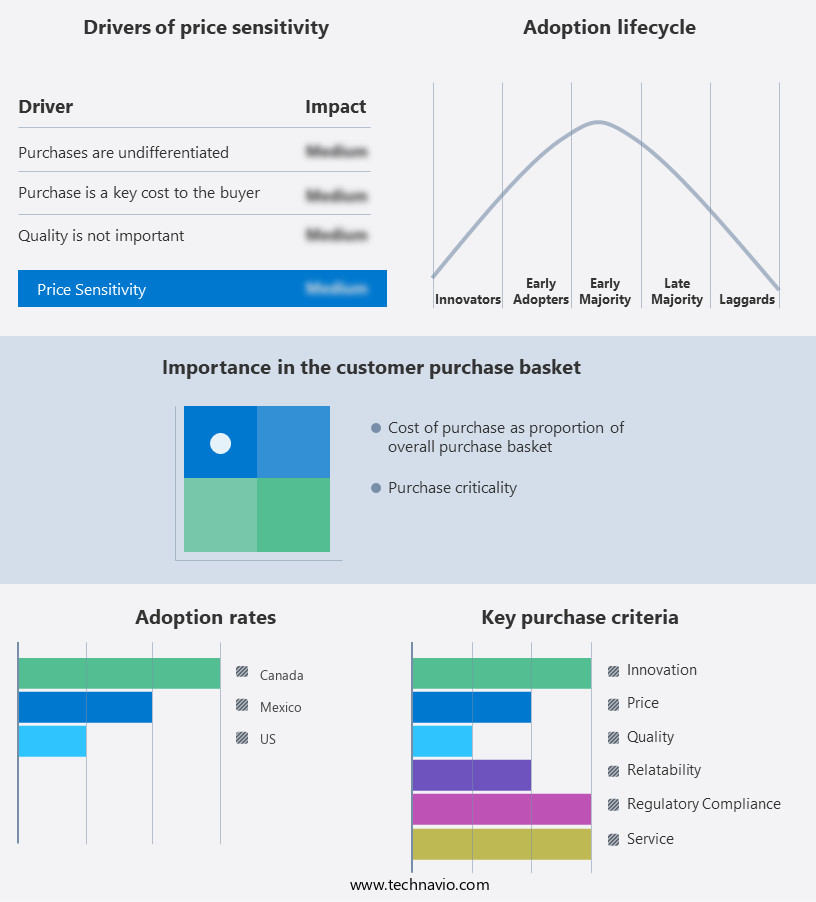
Customer Landscape of North America Cold Chain Logistics Market Industry
Key Companies & Market Insights
Companies are implementing various strategies, such as strategic alliances, cold chain logistics market in North America forecast, partnerships, mergers and acquisitions, geographical expansion, and product/service launches, to enhance their presence in the market research report.
Americold Realty Trust Inc. - This company specializes in cold chain logistics, delivering comprehensive temperature-controlled storage and state-of-the-art technology services to ensure optimal product preservation. Their solutions cater to various industries, enhancing supply chain efficiency and product integrity.
The market growth and forecasting report includes detailed analyses of the competitive landscape of the market and information about key companies, including:
- Americold Realty Trust Inc.
- ArcBest Corp.
- Burris Logistics Co.
- C H Robinson Worldwide Inc.
- Conestoga Cold Storage
- COVENANT LOGISTICS GROUP INC.
- Deutsche Bahn AG
- DHL Express Ltd
- Expeditors International of Washington Inc.
- FedEx Corp.
- J B Hunt Transport Services Inc.
- KLLM Transportation Services
- Lineage Logistics Holdings LLC
- MARTEN TRANSPORT LTD.
- NewCold Cooperatief UA
- NFI Industries Inc.
- Prime Inc.
- Tippmann Group
- Total Quality Logistics LLC
- XPO Inc.
Qualitative and quantitative analysis of companies has been conducted to help clients understand the wider business environment as well as the strengths and weaknesses of key industry players. Data is qualitatively analyzed to categorize companies as pure play, category-focused, industry-focused, and diversified; it is quantitatively analyzed to categorize companies as dominant, leading, strong, tentative, and weak.
Recent Development and News in Cold Chain Logistics Market In North America
- In January 2024, Walmart, a leading retailer in North America, announced the expansion of its cold chain logistics capabilities by investing in a new distribution center in Texas. This facility, which covers over 200,000 square feet, will enhance Walmart's ability to store and distribute temperature-controlled goods more efficiently (Walmart Press Release).
- In March 2024, UPS Healthcare Logistics, a division of UPS, and Pfizer, a global pharmaceutical company, entered into a strategic partnership to provide end-to-end cold chain logistics services for Pfizer's COVID-19 vaccine. This collaboration ensured the timely and efficient distribution of the vaccine across North America (UPS Press Release).
- In April 2025, Lineage Logistics, a leading cold storage solutions provider, announced the acquisition of Preferred Freezer Services, a major player in the US frozen food storage market. This acquisition expanded Lineage's network to over 400 facilities and increased its market share in the North American cold chain logistics market (Lineage Logistics Press Release).
- In May 2025, FedEx Express, a subsidiary of FedEx Corp., unveiled its new automated cold chain handling system at its Memphis hub. This innovative technology, which uses temperature-controlled conveyor belts and advanced sensors, significantly improved the speed and accuracy of handling temperature-sensitive goods in the FedEx network (FedEx Press Release).
Research Analyst Overview
- The market is a dynamic and evolving sector, characterized by the continuous integration of advanced technologies and strategies to optimize the transportation, handling, and storage of perishable goods. This market encompasses various applications across industries, including food and beverage, pharmaceuticals, and chemical manufacturing. One significant trend in this market is the integration of RFID technology for real-time temperature monitoring and supply chain visibility. This technology enables carriers to track and monitor temperature-controlled cargo in real-time, ensuring compliance with cold chain regulations and maintaining product quality. For instance, a leading food distributor reported a 25% reduction in spoilage due to improved temperature control using RFID technology.
- Another critical aspect of the cold chain logistics market is fuel consumption monitoring and carrier selection. By analyzing carrier performance data, logistics managers can optimize their carrier selection process, reducing fuel consumption and carbon footprint. The North American cold chain logistics market is expected to grow by 5% annually, driven by the increasing demand for energy-efficient refrigeration, waste reduction strategies, and automation systems. Frozen food transport and cold storage warehousing are essential components of the cold chain logistics market. Automated guided vehicles (AGVs) and temperature data logging are increasingly being adopted to streamline operations and improve efficiency. Moreover, route optimization algorithms, blockchain for traceability, and shipment tracking technology are revolutionizing the last-mile delivery process.
- The cold chain logistics market is also focused on implementing quality control measures, such as temperature monitoring systems and real-time location tracking, to ensure food safety regulations are met. Logistics software platforms, inventory management systems, container tracking systems, and driver behavior monitoring are some of the technologies that facilitate these efforts. In conclusion, the North American cold chain logistics market is undergoing significant changes, driven by the integration of advanced technologies and strategies to optimize temperature-controlled supply chains. These innovations aim to reduce fuel consumption, enhance supply chain visibility, improve warehouse operations, and ensure regulatory compliance.
Dive into Technavio's robust research methodology, blending expert interviews, extensive data synthesis, and validated models for unparalleled Cold Chain Logistics Market in North America insights. See full methodology.
|
Market Scope
|
|
Report Coverage
|
Details
|
|
Page number
|
160
|
|
Base year
|
2023
|
|
Historic period
|
2018-2022 |
|
Forecast period
|
2024-2028
|
|
Growth momentum & CAGR
|
Accelerate at a CAGR of 16.4%
|
|
Market growth 2024-2028
|
USD 111.74 billion
|
|
Market structure
|
Fragmented
|
|
YoY growth 2023-2024(%)
|
12.7
|
|
Key countries
|
US, Canada, and Mexico
|
|
Competitive landscape
|
Leading Companies, Market Positioning of Companies, Competitive Strategies, and Industry Risks
|
Request Free Sample
What are the Key Data Covered in this Cold Chain Logistics Market in North America Research and Growth Report?
- CAGR of the North America Cold Chain Logistics Market industry during the forecast period
- Detailed information on factors that will drive the growth and market forecasting between 2024 and 2028
- Precise estimation of the size of the market and its contribution of the industry in focus to the parent market
- Accurate predictions about upcoming growth and trends and changes in consumer behaviour
- Growth of the market across North America
- Thorough analysis of the market's competitive landscape and detailed information about companies
- Comprehensive analysis of factors that will challenge the cold chain logistics market in North America growth of industry companies
We can help! Our analysts can customize this cold chain logistics market in North America research report to meet your requirements.
Get in touch







![]() Get the report (PDF) sent to your email within minutes.
Get the report (PDF) sent to your email within minutes.
Complimentary full Excel data with your report purchase.